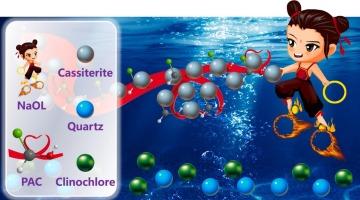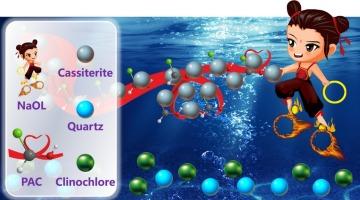聚合氯化铝在锡石絮凝浮选中的应用
IF 6.9
2区 材料科学
Q2 CHEMISTRY, PHYSICAL
引用次数: 0
摘要
在微细粒锡石的分离过程中,传统的重选和浮选方法对从脉石中分离锡石效果不佳。本研究将聚合氯化铝(PAC)作为新型絮凝剂应用于油酸钠(NaOL)体系中对锡石、石英和斜石的絮凝浮选分离,取得了锡石的成功分离。浮选试验表明,在pH为8、油酸钠用量为80 mg/L、PAC用量为7 mg/L的条件下,锡石的最大回收率为62.48 %,品位为81.09 %。并通过接触角分析、激光粒度分析、zeta电位测量、扫描电镜和x射线光电子能谱(XPS)测试对絮凝浮选机理进行了研究。结果表明,PAC能有效地絮凝锡石。值得注意的是,油酸钠的掺入并没有降低PAC的絮凝强度和收集能力。本文章由计算机程序翻译,如有差异,请以英文原文为准。


Application of poly aluminum chloride in cassiterite flocculation flotation
In the separation process of micro-fine cassiterite, traditional gravity separation and flotation methods proved ineffective in isolating cassiterite from gangue. This study introduced poly aluminum chloride (PAC) as a novel flocculant in the flocculation-flotation separation of cassiterite, quartz, and clinochlore within a sodium oleate (NaOL) system, which led to successful cassiterite separation. Flotation experiments indicated that the maximum recovery rate of cassiterite reached 62.48 % with a grade of 81.09 % under optimal conditions: pH 8, sodium oleate dosage of 80 mg/L, and PAC dosage of 7 mg/L. Additionally, the flocculation-flotation mechanism was examined through contact angle analysis, laser particle size analysis, zeta potential measurements, scanning electron microscopy, and X-ray photoelectron spectroscopy (XPS) testing. The findings demonstrated that PAC effectively flocculated cassiterite. Notably, the incorporation of sodium oleate did not diminish the flocculation strength or the collecting capacity of PAC.
求助全文
通过发布文献求助,成功后即可免费获取论文全文。
去求助
来源期刊

Applied Surface Science
工程技术-材料科学:膜
CiteScore
12.50
自引率
7.50%
发文量
3393
审稿时长
67 days
期刊介绍:
Applied Surface Science covers topics contributing to a better understanding of surfaces, interfaces, nanostructures and their applications. The journal is concerned with scientific research on the atomic and molecular level of material properties determined with specific surface analytical techniques and/or computational methods, as well as the processing of such structures.
 求助内容:
求助内容: 应助结果提醒方式:
应助结果提醒方式:


